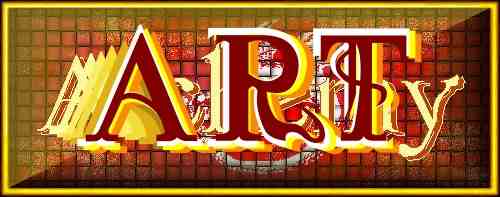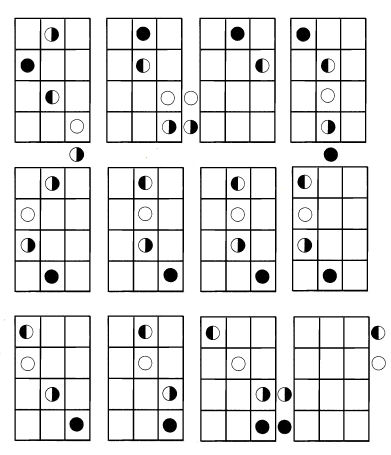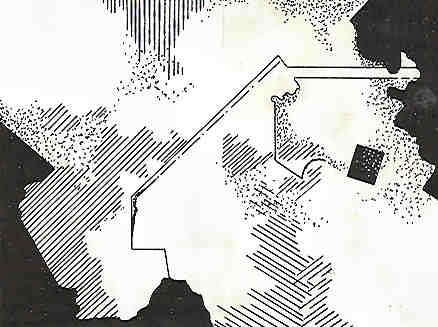

| The tenth process of Exaltation is also called The Philosopher's Stone. During Exaltation, the pure state exists. |
![]() The pure state is the culmination of all the work which has gone before. It is composed of the basic, essential art elements combined and arranged in a composition in a way that it is more than merely an image of reality but rather a facsimile of reality. It is no longer dependent on any other element to give it life; it breathes a life of its own by virtue of the pure elements of which it is composed, and the faithful, diligent methods by which it was conceived and created. It becomes the embodiment of the Philosopher’s Stone in that (by nature of its existence as a reality in itself) it may be utilized to create a new spark of motivation.
The pure state is the culmination of all the work which has gone before. It is composed of the basic, essential art elements combined and arranged in a composition in a way that it is more than merely an image of reality but rather a facsimile of reality. It is no longer dependent on any other element to give it life; it breathes a life of its own by virtue of the pure elements of which it is composed, and the faithful, diligent methods by which it was conceived and created. It becomes the embodiment of the Philosopher’s Stone in that (by nature of its existence as a reality in itself) it may be utilized to create a new spark of motivation.
![]() I have, up to this point, dealt with a correlation between alchemy and ‘art’. It is in the process of Exaltation that the concept of ‘shNn’ manifests its existence in relation to ART. So it is now necessary to comment on that concept.
I have, up to this point, dealt with a correlation between alchemy and ‘art’. It is in the process of Exaltation that the concept of ‘shNn’ manifests its existence in relation to ART. So it is now necessary to comment on that concept.
![]() The sHNn concept was devised by Larry Smith as a technique by which to create an art which is not merely a reflected image of reality but rather a reproduction of reality. SHNn derives its motivational force from metaphysical sources. Its premise is stated as: "it is my intention in sHnN toproduce experiences which possess both chaos and order in order that the individual perceiving the experience will not be exactly certain whether order or whether chaos exists."
The sHNn concept was devised by Larry Smith as a technique by which to create an art which is not merely a reflected image of reality but rather a reproduction of reality. SHNn derives its motivational force from metaphysical sources. Its premise is stated as: "it is my intention in sHnN toproduce experiences which possess both chaos and order in order that the individual perceiving the experience will not be exactly certain whether order or whether chaos exists."
![]() Reality exists in the form of manifestations of this premise all around us. Chaos and order coexist in all things; one principle may dominate the perceptual awareness of the viewer in a particular thing but this alone does not negate the fact that the other principle exists in that particular thing also. The macrocosm of a particular thing may exhibit a sort of chaos to the beholder, but upon closer inspection he may find a sense of order to the chaos or to the mechanism which produces the illusion of chaos.
Reality exists in the form of manifestations of this premise all around us. Chaos and order coexist in all things; one principle may dominate the perceptual awareness of the viewer in a particular thing but this alone does not negate the fact that the other principle exists in that particular thing also. The macrocosm of a particular thing may exhibit a sort of chaos to the beholder, but upon closer inspection he may find a sense of order to the chaos or to the mechanism which produces the illusion of chaos.
![]() Take, for example, the perception of the universe. Before man had the means to explore the universe, it was thought to possess elements of chaos which could only be explained in religious terms. With the invention of the telescope and other specialized apparatus man could make a closer inspection of the vast spaces surrounding him and it was discovered that the universe possessed order (in such things as the existence of similar gaseous bodies and their movements). But then upon even closer inspection it was discovered that coexisting with these ordered elements of bodies and movements were chaotic elements (in such things as black holes). Perhaps an order will be found to exist in even these chaotic things.
Take, for example, the perception of the universe. Before man had the means to explore the universe, it was thought to possess elements of chaos which could only be explained in religious terms. With the invention of the telescope and other specialized apparatus man could make a closer inspection of the vast spaces surrounding him and it was discovered that the universe possessed order (in such things as the existence of similar gaseous bodies and their movements). But then upon even closer inspection it was discovered that coexisting with these ordered elements of bodies and movements were chaotic elements (in such things as black holes). Perhaps an order will be found to exist in even these chaotic things.
![]() Man himself, it was found, existed as a microcosm to the macrocosm of the universe in that the body itself correlates with the perceptual nature of the universe. An existential / metaphysical view of man reveals that the body is a chaotic manifestation which is brought into existence, runs its course and then vanishes through death. The physical mechanism proceeds through this course of existence in a basically ordered fashion while the mental mechanism proceeds chaotically from one time and space to another.
Man himself, it was found, existed as a microcosm to the macrocosm of the universe in that the body itself correlates with the perceptual nature of the universe. An existential / metaphysical view of man reveals that the body is a chaotic manifestation which is brought into existence, runs its course and then vanishes through death. The physical mechanism proceeds through this course of existence in a basically ordered fashion while the mental mechanism proceeds chaotically from one time and space to another.

![]() For the most part humans pass through their existence without recognition of the order and chaos that exists around them. Reality exists in two forms: perception and the act of perceiving. The perception manifested by any particular thing may be constant and unalterring whereas the act of perceiving it may vary between any two individuals. Neither of the individuals have any way of knowing how the other perceives the thing, although they both may attempt to describe their act to each other. But by doing so the two individuals can only come to a mutual consensus according to the type and amount of relationships either one can acknowledge in the other’s description. What evolves is that the reality which one individual perceives may possess a recognition of order while that same reality may be perceived by the other as possessing chaos.
For the most part humans pass through their existence without recognition of the order and chaos that exists around them. Reality exists in two forms: perception and the act of perceiving. The perception manifested by any particular thing may be constant and unalterring whereas the act of perceiving it may vary between any two individuals. Neither of the individuals have any way of knowing how the other perceives the thing, although they both may attempt to describe their act to each other. But by doing so the two individuals can only come to a mutual consensus according to the type and amount of relationships either one can acknowledge in the other’s description. What evolves is that the reality which one individual perceives may possess a recognition of order while that same reality may be perceived by the other as possessing chaos.
![]() Going back to the original premise, the ShNn concept’s import is to urge the artist to discover the randomness of order and chaos which reality holds and then to utilize the knowledge and experience of that discovery to dictate the nature of the artwork. The reference in the stated premise that the utilization of randomness is aimed toward production of art ‘in order that the individual perceiving the experience will not be exactly certain whether order or whether chaos exists’ is not meant to imply that the artwork so produced is intended as a delusion for the purpose of fooling the viewer. What is inferred here is that if the microcosm of the artwork is to simulate the macrocosm of the reality it must possess pure, essential elements (of design and composition) and provide the viewer with the same wealth of randomness that reality provides so that the viewer is thereby not restricted in the exercising of his perceptual abilities. If the artwork is to breathe a life of its own and exist as a reality by itself it must not be merely a reflected image of reality; it must of necessity exist as a perception of its own accord, free and accessible to the viewer’s act of perceiving it on the viewer’s own terms.
Going back to the original premise, the ShNn concept’s import is to urge the artist to discover the randomness of order and chaos which reality holds and then to utilize the knowledge and experience of that discovery to dictate the nature of the artwork. The reference in the stated premise that the utilization of randomness is aimed toward production of art ‘in order that the individual perceiving the experience will not be exactly certain whether order or whether chaos exists’ is not meant to imply that the artwork so produced is intended as a delusion for the purpose of fooling the viewer. What is inferred here is that if the microcosm of the artwork is to simulate the macrocosm of the reality it must possess pure, essential elements (of design and composition) and provide the viewer with the same wealth of randomness that reality provides so that the viewer is thereby not restricted in the exercising of his perceptual abilities. If the artwork is to breathe a life of its own and exist as a reality by itself it must not be merely a reflected image of reality; it must of necessity exist as a perception of its own accord, free and accessible to the viewer’s act of perceiving it on the viewer’s own terms.
![]() The processes up to this point, from Calcination to Fermentation, are necessary prerequisites to insure that the artwork is based and composed of the elements of the essence of reality. Should the artist forego any one process, the total is affected. The history of alchemy evidences this fact. Different authors have proposed varying or noncommitted quantities and natures of the ingredients which they put into the alembic and varying instructions on the amount of heat or the nature of exterior influence which is necessary to maintain the processes, but the one unifying thread which weaves throughout the history of the alchemical act is that the processes must proceed in a set course and schedule and must all be included for the eventual Philosopher's Stone to come into existence.
The processes up to this point, from Calcination to Fermentation, are necessary prerequisites to insure that the artwork is based and composed of the elements of the essence of reality. Should the artist forego any one process, the total is affected. The history of alchemy evidences this fact. Different authors have proposed varying or noncommitted quantities and natures of the ingredients which they put into the alembic and varying instructions on the amount of heat or the nature of exterior influence which is necessary to maintain the processes, but the one unifying thread which weaves throughout the history of the alchemical act is that the processes must proceed in a set course and schedule and must all be included for the eventual Philosopher's Stone to come into existence.
![]() If and only if the artwork possesses a unification and merger of the spirit (inspiration, imagination, will), the soul (emotion, desire, purpose) and the salt (physicality, materiality, corporeality) of the total essence of reality can it exist alone by itself as a reality perception. And if the artwork does indeed possess such a unified state of being it can be used to motivate the production of other art.
If and only if the artwork possesses a unification and merger of the spirit (inspiration, imagination, will), the soul (emotion, desire, purpose) and the salt (physicality, materiality, corporeality) of the total essence of reality can it exist alone by itself as a reality perception. And if the artwork does indeed possess such a unified state of being it can be used to motivate the production of other art.
![]() SHNN embodies the essence of the Philosopher's Stone in that it serves as a catalyst to produce and multiply ART. The concept of shNn exists as a manifesto unto itself to call for the artist to embrace an active search and discovery of the randomness which exists in reality and to utilize those discoveries to produce an art of equal randomness.
SHNN embodies the essence of the Philosopher's Stone in that it serves as a catalyst to produce and multiply ART. The concept of shNn exists as a manifesto unto itself to call for the artist to embrace an active search and discovery of the randomness which exists in reality and to utilize those discoveries to produce an art of equal randomness.

